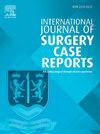体外受精后异位妊娠,宫颈和子宫各一个。羊膜内杀胎术终止宫颈妊娠后成功分娩。
IF 0.6
Q4 SURGERY
引用次数: 0
摘要
宫颈妊娠是一种罕见的异位妊娠。异位妊娠是一种情况,我们在子宫里有一个囊,另一个在另一个位置,通常是因为体外受精治疗。如果不及时治疗,这种情况可能会危及生命。病例介绍:一名44岁女性接受体外受精(卵子捐赠)双胚胎移植,导致双胎妊娠,但异位。一个在子宫颈,一个在宫内。直到第8周,两个怀孕都是平等的,然后决定终止子宫颈妊娠。她的医生选择了经腹入路(羊膜穿刺术);然而,这一尝试失败了。然后,由生殖专家尝试用氯化钾注射和羊水抽吸宫颈穿刺。顺利终止妊娠,术后无并发症发生。宫内妊娠进展正常,在39周时实现了活产。讨论:当前的病例代表了一种有趣的方式,终止宫颈妊娠,即使在宫内双胞胎兄弟姐妹的存在。结论:异位妊娠患者不应同时终止妊娠,应转诊到专门的生殖和胎产中心。本文章由计算机程序翻译,如有差异,请以英文原文为准。
Post IVF heterotopic pregnancy with one in cervix and one in uterus. Successful delivery after termination of the cervical pregnancy with intraamniotic feticide
Introduction
Cervical pregnancy is a rare kind of ectopic pregnancy. Heterotopic pregnancy is a condition, where we have one sac in the uterus and one in another location, usually because of IVF treatment. This scenario can become a life-threatening condition, if remain untreated.
Presentation of case
A 44-year-old woman underwent IVF (egg donation) with double embryotransfer and resulted in twin pregnancy, however heterotopic. One in cervix and one intrauterine. Until 8 weeks both pregnancies evoluting equally and then a decision made to terminate the cervical one. Her physician chose a transabdominal approach (amniocentesis wise); however, this attempt failed. Then, intracervical puncture by a reproductive specialist was attempted with potassium chloride injection and aspiration of the amniotic fluid. The pregnancy was terminated successfully, and no complications presented afterwards. The intrauterine pregnancy evoluted normally and a livebirth was achieved at 39 weeks.
Discussion
The current case represents an interesting way of terminating a cervical pregnancy even in the presence of a twin intrauterine sibling.
Conclusion
Patients with heterotopic pregnancies, should be encouraged not to terminate both pregnancies and to be referred in specialized reproductive and fetal maternity centers.
求助全文
通过发布文献求助,成功后即可免费获取论文全文。
去求助
来源期刊
CiteScore
1.10
自引率
0.00%
发文量
1116
审稿时长
46 days

 求助内容:
求助内容: 应助结果提醒方式:
应助结果提醒方式:


